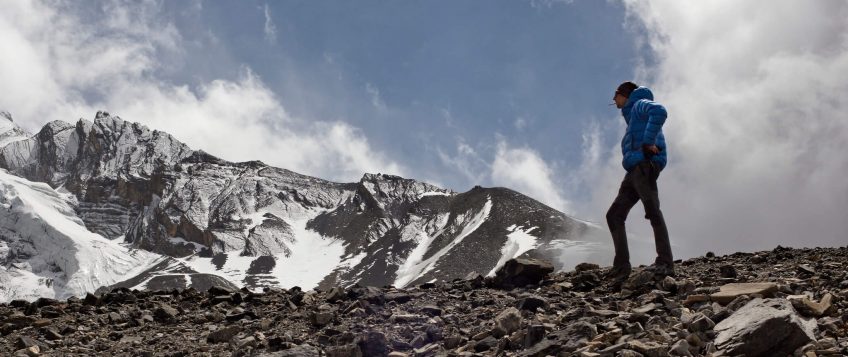The Annapurna Circuit

The Annapurna Circuit attracts a relatively high number of trekkers in Nepal. As the name itself suggests, this trail goes on a circuitous route around the entire Annapurna massif, visiting the Tibet-like country on the northern slopes of the Himalaya and the dramatic Kali Gandaki gorge. Much of Annapurna the trek is through lowland country, but there is one high pass, “Thorung La” (5,380m). The trail over the pass is steep but in good shape and not hard to follow. This is the one point of the entire circuit where you really feel you are amidst the mountains. However you should be aware of altitude sickness and be prepared for weather extremes as the Thorung La is notorious for changing its moods. The pass is usually snowbound and un-crossable form mid-December to mid-April.
The Kali Gandaki gorge is another spell binding part of this trip. Known to be the worlds deepest river gorge the trail upto the Jomsom (and Upper Mustang) actually goes side by side with the river giving the lonely trekker company and groups something to talk about. Thus the Annapurna circuit is an extraordinary trek, truly one of the world’s best. It requires at least three weeks. But due to the popularity of this route it can sometimes tend to be crowded.
The Annapurna Sanctuary
This is probably the most ideal trek: lovely, short and intense, a direct route into the heart of the Himalaya. Spectacular mountain vistas and easy access make it among the most popular treks, with over 10,000 visitors per year. The sanctuary is a hidden pocket of meadow, moraine and glacier, ringed by magnificent sheer-walled the annapurna sanctuary 6,000 – 8,000 meter peaks: the Annapurnas, Gangapurna, Machhapuchhare, Himchuli.
The trek requires ten to fourteens days and begins from Pokhara, passing through lowland villages and rice terraces to mountain glaciers. The trail rises nearly 2000 m in the last 8 km and one needs to plan for acclimatization. The trail is frequently slippery and there’s danger of avalanches in few places, so early spring and winter trekking is unlikely. Accommodation in the lower portion (at least in Chhomrong) are deluxe; the upper stretch is understandably simple – no body lives up there for long time.
Jomsom
Easily accessible via a 20-minute flight from Pokhara, Jomsom lies nestled beneath the splendor of Mount , Nilgiri. For those of you not inclined to make it to the mountains the hard way, i.e. slogging it on foot step by step in a gradual process, taking the US$ 50 flight to Jomsom from Pokhara is the ideal alternative. Jomsom, at an altitude of 2,700 meters lies tucked in between two giant mountain ranges, the Annapurna and Dhaulagiri- both reach out to the sky beyond 8,000 meters at their highest points, and although these ranges are around 35 kilometers apart, consider yourself to be technically positioned at the bottom of the world’s deepest gorge, the Kali Gandaki Valley with a spectacular view of Mt. Nilgiri looming ahead like a huge snowy pyramid.
From Jomsom, one may venture on to leisurely treks for a day or two northwards to Kagbeni or southwards to Marpha, Tukuche, and Lete-Kalopani all of these places can be reached with effortless walking on an almost leveled surface. On the other hand, should the rarefied mountain air hinder your walking ability; you may choose to explore the area on a pony that can be made available by your hotel at a reasonable price. Food and board around Jomsom could probably be described as being the best among all the trekking regions of the country. All the better hotels provide cosy rooms that come with attached bath with running hot water. With three to four flights coming in from Pokhara every day, the larders of most restaurants are well stocked with fresh meat and vegetables.
Muktinath Trek
This major Himalayan highway follows the gorge of the Kali Gandaki River, crossing from subtropical jungle to high-altitude desert in less than one week. Mixed in the stream of international trekkers are Hindu saddhus (ascetic) walking to Muktinath and jingling mule trains heading down from Tibet loaded with bales of wool. Both are reminders of the trail’s status as a major trade and pilgrimage route, an important cultural corridor across the Himalaya.
The end point is the ancient shrine of Muktinath (3,170 meters), one of Nepal’s holiest pilgrimage sites. There’s no real village, but lodges around the lower portion (Ranipauwa) put up pilgrims and trekkers. The ancient holy site is a typically confusing blend of natural, Buddhists and Hindu beliefs. The little Newari-style pagoda to Lord Vishnu is a relatively recent addition. Muktinath has been sacred for over 2000 years; the Hindu holy book Mahabharata mentions it as Shaligrama, “Place of the Shaligram,”the black fossil stones sacred to Vishnu and found in abundance in the Kali Gandaki valley. Its holiness stems from flickering blue flames of natural methane gas burning on water, stone and earth, and now enclosed in the shrine of Jwala Mai below the Vishnu temple. Near the pagoda, there is 108 spouts, shaped like bulls’ heads, where devout pilgrims bathe in the freezing water to purify their sins and earn mukti or spiritual liberation.
The place has ancient association for Buddhists as well; Guru Rinpoche is said to have passed through here en route to Tibet, leaving his footprints in a rock. There are many old Buddhist temples around here.
The entire trek to Muktinath remains below 3000 meters. One should figure at least two weeks to walk in and out, allow a few extra days for exploration- the upper region in particular is lined with fascinating villages. Flying into Jomsom and walking back down is possible, but one should remember to acclimatize before climbing to Muktinath. One can fly from Jomsom to either Kathmandu or Pokhara.
Post a comment
You must be logged in to post a comment.

